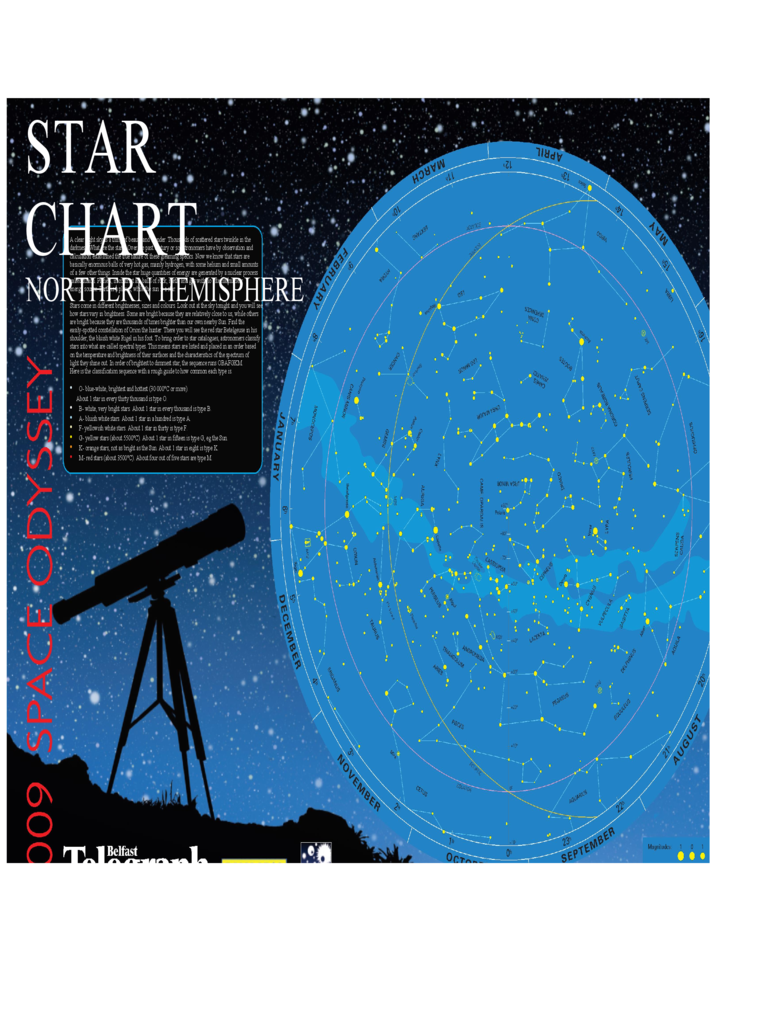Fillable Printable Northern and Southern Hemisphere Star Chart
Fillable Printable Northern and Southern Hemisphere Star Chart

Northern and Southern Hemisphere Star Chart

STAR
CHART
NORTHERN HEMISPHERE
A clear night sky is a thing of beauty and wonder. Thousands of scattered stars twinkle in the
darkness. What are the stars? Over the past century or so astronomers have by observation and
calculation established the true nature of these gleaming specks. Now we know that stars are
basically enormous balls of very hot gas, mainly hydrogen, with some helium and small amounts
of a few other things. Inside the star huge quantities of energy are generated by a nuclear process
called fusion. Planets, in contrast are balls of rock, metal and gas with no internal nuclear
energy source. Earth is a planet, while the sun is a star.
Stars come in different brightnesses, sizes and colours. Look out at the sky tonight and you will see
how stars vary in brightness. Some are bright because they are relatively close to us, while others
are bright because they are thousands of times brighter than our own nearby Sun. Find the
easily-spotted constellation of Orion the hunter. There you will see the red star Betelgeuse in his
shoulder, the bluish white Rigel in his foot. To bring order to star catalogues, astronomers classify
stars into what are called spectral types. This means stars are listed and placed in an order based
on the temperature and brightness of their surfaces and the characteristics of the spectrum of
light they shine out. In order of brightest to dimmest star, the sequence runs OBAFGKM.
Here is the classification sequence with a rough guide to how common each type is.
• O- blue-white, brightest and hottest (30 000°C or more).
About 1 star in every thirty thousand is type O.
• B- white, very bright stars. About 1 star in every thousand is type B.
• A- bluish white stars. About 1 star in a hundred is type A.
• F- yellowish white stars. About 1 star in thirty is type F.
• G- yellow stars (about 5500°C). About 1 star in fifteen is type G, eg the Sun.
• K- orange stars, not as bright as the Sun. About 1 star in eight is type K.
• M- red stars (about 3500°C). About four out of five stars are type M.

SOUTHERN
HEMISPHERE
.uok apghre.lcet ast .belf
www
T
ATRSC
erst ee ps oyfr’ oTda
SSEYY E COAD
2009 S
2009 SPACE
ODYSSEY
Today’s free poster
STAR CHART
Although the vast majority of stars we see in the night sky are brighter than
the Sun, actually small and dim M type stars called red dwarfs (stars physically
smaller than our Sun are classed as dwarf stars) seem to be the most common
stars in space, at least in our part of the Milky Way galaxy. Of the 100 closest
stars to the Sun, 80 are M-type red dwarf stars, too dim be seen with the
naked eye. The fact that the majority of stars we see in the sky are brighter
than the Sun, also means that most stars in the galaxy are too dim for us to
see. It is clear that most stars (about 9 out of 10) are actually smaller and
dimmer than our Sun, and only about 3% are significantly brighter. So actually
our Sun is one of the biggest and brightest stars in the galaxy. It is possible to
plot a graph of stars’ spectral type against their actual brightnesses.
Scientists call this the Hertzsprung-Russell diagram and it is the most
important diagram in astronomy. It shows that stars are divided into several
groups. The most important group is the ‘main sequence’.
fated to become one of these red giants. A third group are the white dwarfs.
These are essentially the cores of dead stars. Red giant stars are believed to
experience huge internal eruptions, blasting off great concentric shells of gas in
the process until eventually all the star’s outer layers have been blown away into
space. The tiny shrunken core, about the size of the Earth, remains as a white
dwarf. White dwarf stars no longer produce light by nuclear fusion, merely
continuing to glow like dying embers until they have slowly cooled to cold black
balls of dense matter not much bigger than a planet. This will be the ultimate
fate of our Sun. Stars larger than ours have more spectacular ends: their red
giant stages terminate in cataclysmic explosions called supernovae. A supernova
is a giant star tearing itself to pieces in nature’s most destructive detonation.
Debris from the explosion forms a great cloud or nebula. At the centre remains a
tiny shrunken remnant composed of strange superdense matter. Such a stellar
corpse is called a neutron star. Larger still stars will explode in a supernova but
leave behind the strangest object of all; a black hole, matter crushed so tightly
that not even light escapes its gravitational grip.
Our Sun is a main sequence star. These are stars in their prime of life, steadily
converting hydrogen into helium in their hot, seething centres and producing
heat and light as a by-product. The red giants are another group. These are
stars which have run out of hydrogen in their cores and are instead generating
energy using other fuels, swelling enormously into huge bloated stars with
reddish surfaces, cool by stellar standards. In the distant future our Sun is
Studying the great cosmic drama of stellar life and death is fascinating,
but most marvellous of all is to step into the night to look up wonder at
this great show above our heads. Happy star-gazing!
Content & Images supplied courtesy of:
www.belfasttelegraph.co.uk
Star charts by Wil Tirion. Copyright
Philip's
PosterPostdesigner desibygnJonathanby JonatSimmshan Simms



